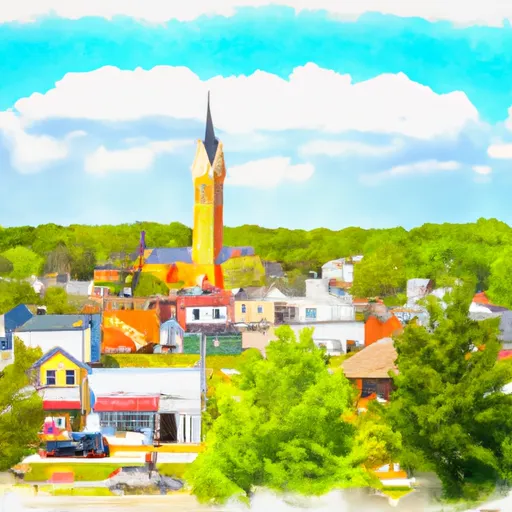-
 Snoflo Premium
Snoflo Premium
Get unlimited access to all our content
With no Ad interruptions! - Start Your Free Trial Login with existing account
Williamsburg
Eden Index
Climate
6.6
•
Recreation
6.6
•
Community
1.1
•
Safeguard
5.2/10

Williamsburg, Michigan is a charming village located in the northern part of the state. The climate in Williamsburg is classified as humid continental, with warm summers and cold winters. Summers are generally mild to warm, with average temperatures ranging from the mid-60s to low 80s Fahrenheit. Winters can be harsh, with temperatures often dropping below freezing and significant snowfall.
Hydrology constituents play a significant role in Williamsburg's landscape. The village is nestled near the eastern shore of Lake Michigan's Grand Traverse Bay, providing residents and visitors with ample opportunities for water-based activities like swimming, boating, and fishing. Inland, the area is dotted with numerous lakes, rivers, and streams, making it a popular destination for kayaking, canoeing, and paddleboarding.
Outdoor enthusiasts will find a plethora of recreational opportunities in Williamsburg. The village is surrounded by scenic forests and rolling hills, offering fantastic hiking and biking trails for all skill levels. The nearby Grass River Natural Area boasts diverse ecosystems, making it a haven for birdwatching and wildlife spotting. Golf enthusiasts will appreciate the championship golf courses in the area.
Overall, Williamsburg, Michigan offers a mix of enjoyable outdoor activities, beautiful natural surroundings, and a climate that supports both summer and winter recreation.
What is the Eden Index?
The Snoflo Eden Index serves as a comprehensive rating system for regions, evaluating their desirability through a holistic assessment of climate health, outdoor recreation opportunities, and natural disaster risk, acknowledging the profound impact of these factors on livability and well-being.
Climate Health Indicator (CHI): 6.6
Williamsburg receives approximately
806mm of rain per year,
with humidity levels near 80%
and air temperatures averaging around
7°C.
Williamsburg has a plant hardyness factor of
5, meaning
plants and agriculture in this region thrive during a short period during spring and early summer. Most
plants will die off during the colder winter months.
By considering the ideal temperature range, reliable water supplies, clean air, and stable seasonal rain or snowpacks, the Climate Health Indicator (CHI) underscores the significance of a healthy climate as the foundation for quality living.
A healthy climate is paramount for ensuring a high quality of life and livability in a region, fostering both physical well-being and environmental harmony. This can be characterized by ideal temperatures, reliable access to water supplies, clean air, and consistent seasonal rain or snowpacks.
Weather Forecast
Streamflow Conditions
Northeastern Lake Michigan
Area Rivers
Northeastern Lake Michigan
Snowpack Depths
Northeastern Lake Michigan
Reservoir Storage Capacity
Northeastern Lake Michigan
Groundwater Levels
Recreational Opportunity Index (ROI): 6.6
The Recreational Opportunity Index (ROI) recognizes the value of outdoor recreational options, such as parks, hiking trails, camping sites, and fishing spots, while acknowledging that climate plays a pivotal role in ensuring the comfort and consistency of these experiences.
Access to outdoor recreational opportunities, encompassing activities such as parks, hiking, camping, and fishing, is crucial for overall well-being, and the climate plays a pivotal role in enabling and enhancing these experiences, ensuring that individuals can engage in nature-based activities comfortably and consistently.
Camping Areas
| Campground | Campsites | Reservations | Toilets | Showers | Elevation |
|---|---|---|---|---|---|
| Tahquamenon Falls 2 State Park | 90 | 752 ft | |||
| Mouth of Two Hearted River - State Forest | 39 | 615 ft | |||
| High Bridge - State Forest | 7 | 720 ft | |||
| Natalie - State Forest | 12 | 722 ft | |||
| Perch Lake - State Forest | 25 | 735 ft | |||
| Muskallonge Lake State Park | 170 | 644 ft | |||
| Headquarters Lake - State Forest | 8 | 740 ft | |||
| Bodi Lake - State Forest | 20 | 650 ft | |||
| Pike Lake (Paradise) - State Forest | 23 | 690 ft | |||
| Culhane Lake - State Forest | 22 | 635 ft |
Nearby Ski Areas
Catastrophe Safeguard Index (CSI):
The Catastrophe Safeguard Index (CSI) recognizes that natural disaster risk, encompassing floods, fires, hurricanes, and tornadoes, can drastically affect safety and the overall appeal of an area.
The level of natural disaster risk in a region significantly affects safety and the overall livability, with climate change amplifying these risks by potentially increasing the frequency and intensity of events like floods, fires, hurricanes, and tornadoes, thereby posing substantial challenges to community resilience and well-being.
Community Resilience Indicator (CRI): 1.1
The Community Resilience Indicator (CRI) recognizes that education, healthcare, and socioeconomics are crucial to the well-being of a region. The CRI acknowledges the profound impact of these elements on residents' overall quality of life. By evaluating educational resources, healthcare accessibility, and economic inclusivity, the index captures the essential aspects that contribute to a thriving community, fostering resident satisfaction, equity, and social cohesion.

